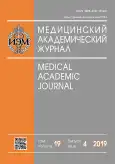Сравнительное иммуногистохимическое и морфометрическое исследование интерлейкина-17 в различных атеросклеротических поражениях у человека
- Авторы: Пигаревский П.В.1, Снегова В.А.1, Мальцева С.В.1, Давыдова Н.Г.1
-
Учреждения:
- ФГБНУ «Институт экспериментальной медицины»
- Выпуск: Том 19, № 4 (2019)
- Страницы: 109-113
- Раздел: Клинические исследования и практика
- URL: https://bakhtiniada.ru/MAJ/article/view/19089
- DOI: https://doi.org/10.17816/MAJ19089
- ID: 19089
Цитировать
Полный текст
Аннотация
Цель — исследовать клеточную и тканевую локализацию интерлейкина-17 (IL-17) в различных атеросклеротических поражениях артерий человека и на основании полученных данных выдвинуть гипотезу о возможной роли T-хелпера 17 (Th17) клеток в дестабилизации атеросклеротической бляшки.
Материалы и методы. На аутопсийном материале с помощью гистологических, иммуногистохимических и морфометрических методов исследования были изучены сегменты аорты, коронарных артерий и a. basilaris с различными типами атеросклеротических поражений (43 образца ткани). В образцах ткани изучали эндотелиальные и мононуклеарные клетки, экспрессирующие IL-17.
Результаты. Показано, что эндотелиальные клетки интимы способны секретировать IL-17 во всех типах атеросклеротических поражений. Одновременно было выявлено увеличение числа мононуклеарных клеток, экспрессирующих IL-17, в интиме артерий. Максимальное число клеток, экспрессирующих IL-17, наблюдалось в интиме нестабильной атеросклеротической бляшки, особенно часто в районе разрыва ее покрышки, что может свидетельствовать о провоспалительном действии Th17-клеток и секретируемого ими IL-17 и о существенном влиянии их на формирование нестабильных атеросклеротических поражений.
Заключение. На основании полученных данных впервые удалось выдвинуть гипотезу о возможной роли Th17-клеток в дестабилизации атеросклеротической бляшки.
Полный текст
Открыть статью на сайте журналаОб авторах
Петр Валерьевич Пигаревский
ФГБНУ «Институт экспериментальной медицины»
Автор, ответственный за переписку.
Email: pigarevsky@mail.ru
ORCID iD: 0000-0002-5906-6771
SPIN-код: 8636-4271
д-р биол. наук, заведующий отделом общей и частной морфологии
Россия, Санкт-ПетербургВлада Андреевна Снегова
ФГБНУ «Институт экспериментальной медицины»
Email: biolaber@inbox.ru
ORCID iD: 0000-0002-9925-2886
SPIN-код: 8088-4446
Scopus Author ID: 55822129200
старший научный сотрудник отдела общей и частной морфологии
Россия, Санкт-ПетербургСветлана Владимировна Мальцева
ФГБНУ «Институт экспериментальной медицины»
Email: pigarevsky@mail.ru
SPIN-код: 8367-9096
канд. биол. наук, старший научный сотрудник отдела общей и частной морфологии
Россия, Санкт-ПетербургНаталья Геннадиевна Давыдова
ФГБНУ «Институт экспериментальной медицины»
Email: pigarevsky@mail.ru
SPIN-код: 4761-3575
канд. мед. наук, старший научный сотрудник отдела общей и частной морфологии
Россия, Санкт-ПетербургСписок литературы
- Симбирцев А.С. Цитокины в патогенезе и лечении заболеваний человека. – СПб.: Фолиант, 2018. – 510 с. [Simbirtsev AS. Tsitokiny v patogeneze i lechenii zabolevaniy cheloveka. Saint Petersburg: Foliant; 2018. 510 р. (In Russ.)]
- Xie JJ, Wang J, Tang TT, et al. The Th17/Treg functional imbalance during atherogenesis in ApoE(-/-) mice. Cytokine. 2010;49(2):185-193. https://doi.org/10.1016/j.cyto. 2009.09.007.
- Ma T, Gao Q, Zhu F, et al. Th17 cells and IL-17 are involved in the disruption of vulnerable plaques triggered by short-term combination stimulation in apolipoprotein E-knockout mice. Cell Mol Immunol. 2013;10(4):338-348. https://doi.org/10.1038/cmi.2013.4.
- Tang X. Analysis of interleukin-17 and interleukin-18 levels in animal models of atherosclerosis. Exp Ther Med. 2019;18(1):517-522. https://doi.org/10.3892/etm.2019.7634.
- Taleb S, Tedgui A, Mallat Z. Interleukin-17: friend or foe in atherosclerosis? Curr Opin Lipidol. 2010;21(5):404-408. https://doi.org/10.1097/MOL.0b013e32833dc7f9.
- Gao Q, Jiang Y, Ma T, et al. A critical function of Th17 proinflammatory cells in the development of atherosclerotic plaque in mice. J Immunol. 2010;185(10):5820-5827. https://doi.org/10.4049/jimmunol.1000116.
- Madhur MS, Funt SA, Li L, et al. Role of interleukin 17 in inflammation, atherosclerosis, and vascular function in apolipoprotein e-deficient mice. Arterioscler Thromb Vasc Biol. 2011;31(7):1565-1572. https://doi.org/10.1161/ATVBAHA. 111.227629.
- Erbel C, Chen L, Bea F, et al. Inhibition of IL-17A attenuates atherosclerotic lesion development in apoE-deficient mice. J Immunol. 2009;183(12):8167-8175. https://doi.org/10.4049/jimmunol.0901126.
- Fatkhullina AR, Peshkova IO, Koltsova EK. The role of cytokines in the development of atherosclerosis. Biokhimiia. 2016;81(11):1358-1370. https://doi.org/10.1134/S0006297916110134.
- Пигаревский П.В. Атеросклероз. Нестабильная атеросклеротическая бляшка (иммуноморфологическое исследование): атлас. – СПб.: СпецЛит, 2018. – 148 с. [Pigarevskiy PV. Ateroskleroz. Nestabil’naya ateroskleroticheskaya blyashka (immunomorfologicheskoe issledovanie): atlas. Saint Petersburg: SpetsLit; 2018. 148 p. (In Russ.)]
Дополнительные файлы








